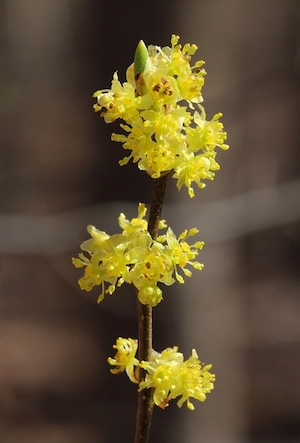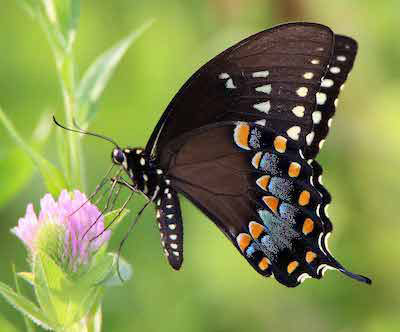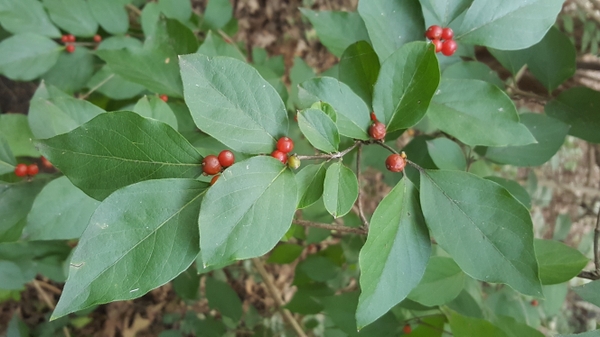Add Some Spicebush to Your Life
By Pat Dickey, Fairfax Master Gardener

Spicebush blooms
Spicebush has many qualities that make it an adaptable native plant in various growing conditions. A local nature center had a native plant sale recently, and I purchased two of these interesting shrubs to grow near the wooded area behind my house, after a recommendation from the naturalist there.
Spicebush (Lindera benzoin) is a member of the Laurel family (Lauraceae). Its genus name Lindera honors Johann Linder (1676-1723), a Swedish botanist and physician. The species name benzoin is from an Arabic word meaning aromatic gum. Lindera benzoin has other common names, Northern Spicebush and Wild Allspice. It is native to eastern North America from Maine and New Hampshire to Kansas, Texas and northern Florida. It grows well in Zones 4 to 9. Spicebush grows in full sun to full shade, preferring part shade as an understory plant in the woods. It enjoys moist well-drained soil that is somewhat sandy. It would be an excellent choice for a rain garden or hedge as well, with low maintenance and fragrant leaves when crushed. In the wild, Spicebush can be found along streams, in flood plains and ravines, and also in drier upland forest areas. Acidic and alkaline soils are both well tolerated, but the Spicebush is found more abundantly in areas with slightly alkaline soil. It is also a close relative to the Sassafras tree (Sassafras albidum).

Spicebush Swallowtail
This deciduous shrub is either single- or few-stemmed with light green branches. Dense yellow flowers bloom in March before the leaves emerge from globose buds along the twigs. The flowers appear in umbel-like clusters. The flowers can be showy if there are large numbers of them, but the flowers themselves are small in size. The leaves are oblong and obovate, tapering to the base. They are light green and turn yellow in autumn. The leaves grow in an alternate formation on the stem. They are 6 inches long and 2 1/2 inches wide and have no teeth or lobes on them.
Spicebush also has red fruits on the female plants in the species, but a male plant is necessary nearby to produce viable seeds for reproduction. The fruit drupes are visible on female plants in September and October. This shrub is dioecious with male (staminate) and female (pistillate) flowers on separate plants. There seems to be more male plants than female ones available for purchase. Both the flowers and fruits are fragrant. The drupes attract many species of birds, including vireos, tanagers, robins and thrushes. Spicebush is also a larval host for the Eastern Tiger Swallowtail (Papillo glaucus) and the Spicebush Swallowtail (Papillo troilus) butterflies.

Spicebush leaves and berries
A spicebush can stand 4 to 12 feet tall with a rounded shape. When it grows in full shade, its structure is more open and wide-spreading. It reproduces by root sprouting and forming clumps or thickets. In the North, spicebush is nicknamed “forsythia of the wilds.” Deer do not usually bother it. There are no serious disease or insect issues described in the literature, although it is susceptible to laurel wilt. It is difficult to transplant because of its fibrous root systems. Spicebush tolerates drought, clay soil and wet soil and is not negatively affected by black walnut trees nearby. A tea, first used by Native Americans, can be made from its aromatic leaves and twigs, and powdered fruit can be used as a spice. The Virginia Native Plant Society named Lindera benzoinas the Native Plant of the Year in 2006.
There are three cultivars of Spicebush in the literature, but none are readily available. ‘Rubra’ is occasionally found and is non-fruiting with red-brown blooms. ‘Green Gold’ is also non-fruiting with very large ornamental yellow flowers. ‘Xanthocarpa’ has orange-yellow fruit.
I look forward to seeing my two spicebush shrubs mature and bring native birds, pollinators and butterflies to my yard. Please consider the spicebush when planning your garden.
Resources
2006 Spicebush (Lindera benzoin), W. John Hayden, Virginia Native Plant Society
Spicebush, Lindera benzoin, Cathy Caldwell, Piedmont Master Gardeners
Spicebush, Lindera benzoin, Lady Bird Johnson Wildflower Center, Austin, Texas
Lindera benzoin, Missouri Botanical Garden